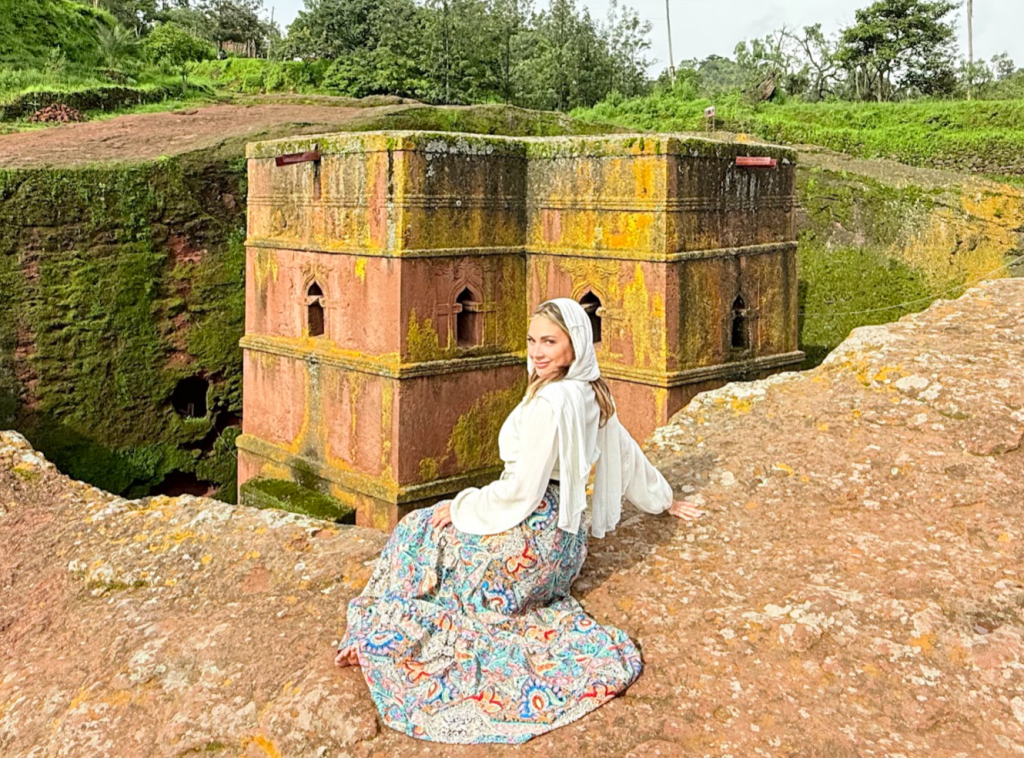
Most people haven’t heard of the rock-hewn churches of Lalibela, Ethiopia, which is exactly why I wanted to make it my next solo adventure. I had seen a photo of what looked like a massive cross carved deep into the ground many years ago, but without much information posted about it, it stayed in the back of my mind like an unsolved travel mystery.
Well, and the first time I attempted going to Ethiopia, it was at the height of their recent civil war, and I was denied a visa upon arrival. (Nothing says “adventure blogger problems” quite like being turned away at immigration, right?) But recently I traveled 28 hours alone to get there and trusted a local guide to show me the historical sites and educate me on the history.
What I experienced was absolutely surreal and mind-blowing. Churches carved from the top down by hand (and allegedly with help from angels) that require tunnels and stairs to get to, and hundreds of locals adorned in sheer white religious scarves coming to pray, looking at me with curiosity and some with awe. It was like stepping into a living, breathing piece of ancient history that most of the world has completely overlooked.
If you want to re-live the adventure, read on for all of my tips, and also easy options to book my same tour!
Before you get all this amazing free info, please consider using my affiliate links below to book your trip! It costs you nothing and I get a small referral which is what helps my blog running! Thank you!
- Flights: Use Skyscanner for cheapest comparisons
- Travel Insurance: HIGHLY recommended! I use Travelex or World Nomads
- Travel Credit Cards: Best Travel Cards for Points
Also don’t forget that if you need any travel gear or clothes like I wear, to click the SHOP tab on the menu above!
Jump To:
The History of Lalibela: When a King Had Divine Architectural Dreams
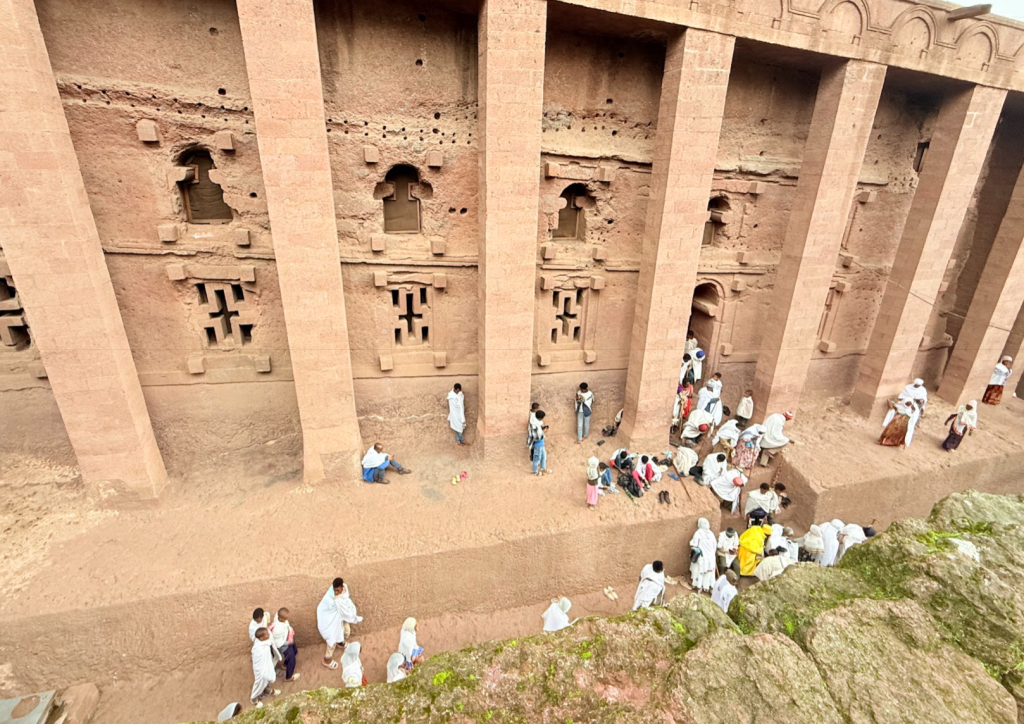
Picture this: It’s the 12th century, and King Lalibela has a vision (literally) to create a “New Jerusalem” in the heart of Ethiopia. According to legend, angels worked alongside humans during the night to carve these incredible churches directly into volcanic rock. Whether you believe in divine intervention or just appreciate some seriously impressive medieval engineering, the result is nothing short of miraculous.
These aren’t your typical churches built up from the ground – they’re carved downward into solid rock, creating underground sanctuaries that have survived nearly 900 years. King Lalibela wanted to create a pilgrimage site for Ethiopian Christians who couldn’t make the journey to the Holy Land, and honestly? Mission accomplished. The entire complex is designed to represent the biblical landscape of Jerusalem, complete with a river called Jordan running through it.
The craftsmanship is mind-boggling when you consider they had no modern tools – just chisels, determination, and apparently some heavenly assistance. Each church took decades to complete, and the precision is so perfect that archaeologists still scratch their heads trying to figure out exactly how they did it.
How to Get to Lalibela: Your Journey Back in Time
Getting to Lalibela requires a bit of planning (and patience), but trust me, it’s worth every bumpy minute. The town sits at 8,200 feet above sea level in the Ethiopian Highlands, so prepare for some thin air and dramatic mountain scenery.
Flying to Lalibela is the Main Way
The easiest route is flying into Lalibela Airport (LLI) from Addis Ababa. Ethiopian Airlines operates daily flights that take about 1.5 hours – infinitely better than the 12-hour overland journey on winding mountain roads.
You can book the flights on your own, or select a tour that includes them! Check for the cheapest flight options here!
A Guided Tour is Essential
Before I dive into this, just going to mention that we will likely do a group trip here in the next year or two! Please fill out this form if you’re interested in getting notified! ETHIOPIA TRAVEL TRIBE
Here’s where I’m going to swallow my solo traveler pride and strongly recommend booking a guided tour. In fact, I’m going to go ahead and say it’s mandatory.
I’m usually a “figure it out as I go” kind of traveler, but Lalibela is different. Logistics are difficult for sure but also, the historical and religious significance of these sites runs so deep that having a knowledgeable local guide transforms the experience from “wow, cool rocks” to “OMGsh, I’m standing in a 900-year-old architectural miracle.” (Don’t say “oh my God”…they are extremely religious there!)
Local guides know the stories, the hidden passages, the best times to visit each church, and can help you navigate the religious customs respectfully. Plus, they will help you take amazing photos like you see here!
I did all of my tours withAman Ethiopia Tour and Travel, and coordinated mostly through Whatsapp! If self-coordinating that way isn’t your vibe, please email me and I’ll be happy to do it for you at no extra cost to you! Info@mylifesamovie.com
Otherwise, you can book one of the tours online for similar pricing, but I can’t fully vouch for the quality since I only did mine through Aman Travels and Tours!
The 10 Churches of Lalibela: A Manmade World Wonder
I’ve been to all 7 of the “New World Wonders” and I’ve seen the remainders of the Ancient ones. I can honestly attest that the Lalibela churches should be on that list instead of half of the places listed. Each church has its own personality and purpose, carved with incredible precision into the bedrock. Here’s your guide to the magnificent ten:
1. Bet Giyorgis (Church of St. George):
The crown jewel and most photographed church – that perfect cross shape carved into the ground that probably sparked your Lalibela dreams in the first place. It’s carved in the shape of a Greek cross and is considered the masterpiece of the entire complex.
2. Bet Maryam (House of Mary): Often considered the most beautiful, this church features intricate carvings and is believed to be the first one completed. The carved windows and decorative elements are so detailed, you’ll wonder how they achieved such precision with medieval tools.
2. Bet Meskel (House of the Cross): Named after the cross-shaped windows carved into its walls, this church has a mysterious, almost mystical atmosphere with its play of light and shadow.
3. Bet Danaghel (House of Virgins): Legend says this was built for nuns and unmarried women. The interior features beautiful carved pillars and arches that create an incredibly serene space.
4. Bet Mikael (House of Michael): This church honors the Archangel Michael and showcases some of the most sophisticated architectural techniques used in the complex.
5. Bet Golgotha (House of Golgotha): Also known as the Tomb of Adam, this is considered the holiest church in Lalibela. Women aren’t traditionally allowed inside, but you can peer through the entrance to see the incredible carved reliefs.
7. Bet Amanuel (House of Emmanuel): This church resembles a traditional Ethiopian palace and is carved to look like it’s built up rather than down, showcasing the incredible skill of the architects.
8. Bet Qeddus Mercoreus (House of St. Mercoreus): Known for its unique architectural style that blends different influences, this church has a more intimate, contemplative atmosphere.
9. Bet Abba Libanos (House of Abbot Libanos): Partially carved from rock and partially built, this church is connected to the cliff face and offers a different perspective on the construction techniques used.
10. Bet Lehem (House of Bread/Bethlehem): The final church in the complex, representing the birthplace of Christ in this New Jerusalem, with beautiful carved details and a peaceful atmosphere.
Other Things to Do in Lalibela: Beyond the Churches
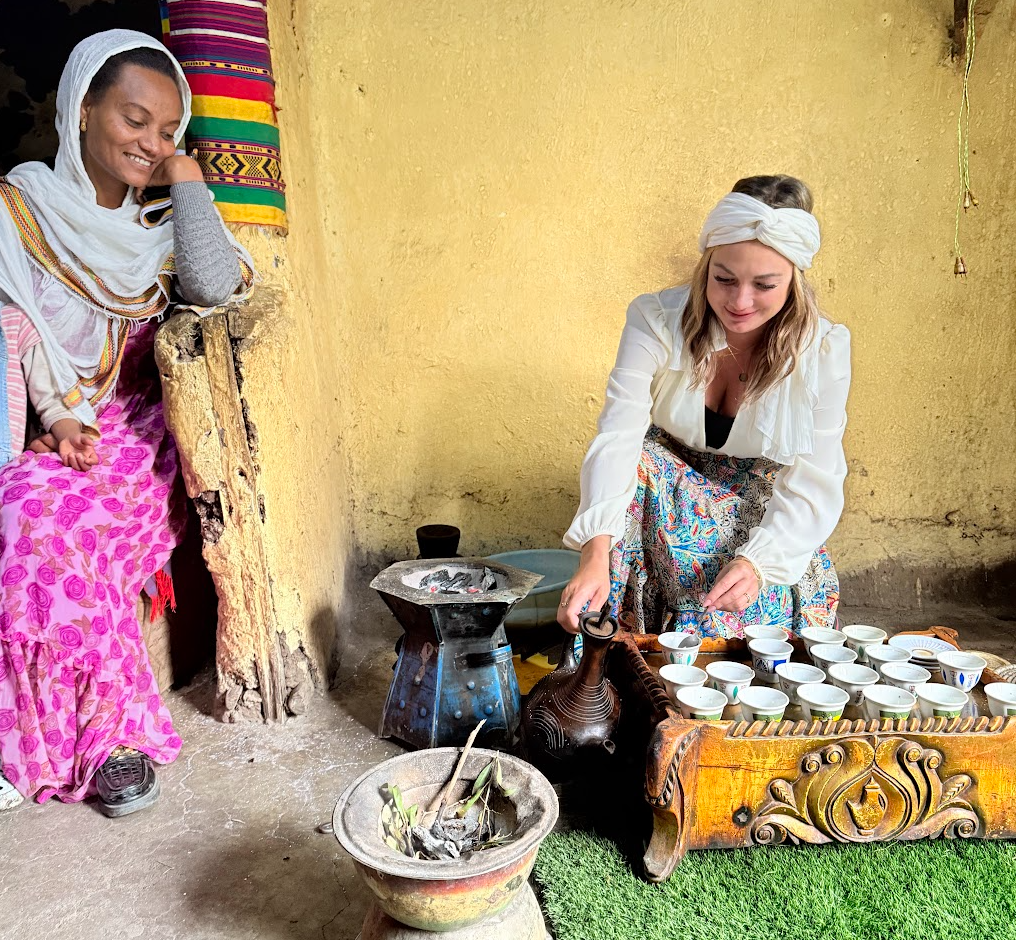
While the churches are obviously the main attraction, Lalibela offers some delightful cultural experiences that’ll give you a deeper connection to Ethiopian life.
Get a Traditional Chiffon Dress Made: I couldn’t resist having a local seamstress create a traditional white chiffon dress for me – the same style worn by Ethiopian women during religious ceremonies. Watching her work on this ancient sewing machine while we chatted about life in Lalibela was honestly as memorable as visiting the churches. Plus, now I have the perfect outfit for any future Ethiopian adventures (and it makes for great Instagram content, let’s be real).
Ethiopian Coffee and Injera Cooking Class: Ethiopia is the birthplace of coffee, so skipping a traditional coffee ceremony would be like going to Italy and not eating pasta. I found a local café where they taught me the entire process – from roasting the green beans over an open flame to brewing it in a traditional clay pot called a jebena. The ritual is meditative and social, often taking over an hour.
They also showed me how to make injera, the spongy sourdough flatbread that’s a staple of Ethiopian cuisine. Fair warning: it’s harder than it looks, and my attempts looked more like pancake disasters than authentic injera. But the laughter shared over my cooking failures was worth every wonky pancake.
Where to Stay in Lalibela: Rest Your Head After All That Rock Climbing
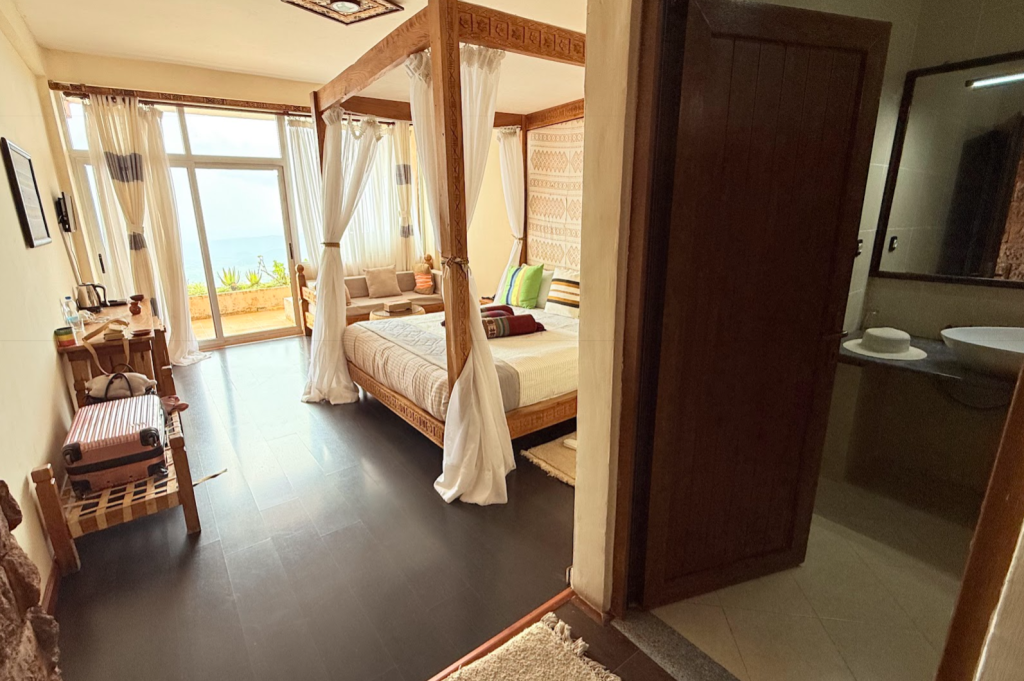
Accommodation options in Lalibela range from basic guesthouses to more comfortable hotels, though don’t expect five-star luxury – this is a small mountain town focused on pilgrimage, not resort living. I stayed at Mirabela Hotel and in my opinion, it was a beautiful mix of luxury, culture, and nature!
Here’s some options, which also can be booked through the tour company I went with!
Mirabela Hotel: A solid mid-range option with clean rooms, hot water (a blessing at this altitude), and a restaurant serving both Ethiopian and international cuisine. The staff is incredibly helpful with arranging guides and transportation.
Lalibela Lodge: If you want to splurge a bit, this lodge offers more upscale accommodations with traditional Ethiopian architecture and stunning views of the surrounding highlands.
Mountain View Hotel: A budget-friendly option that’s clean and comfortable, with a great rooftop terrace perfect for watching the sunrise over the mountains.
Ben Abeba Restaurant & Lodge: Unique architecture that looks like something from a fairy tale, with incredible views and a restaurant that serves some of the best food in town.
Pro tip: Book accommodations in advance, especially during major Ethiopian Orthodox holidays when pilgrims flock to Lalibela. Also, pack layers – mountain nights get surprisingly chilly even when days are warm.
Is Lalibela Safe for Solo Female Travelers?
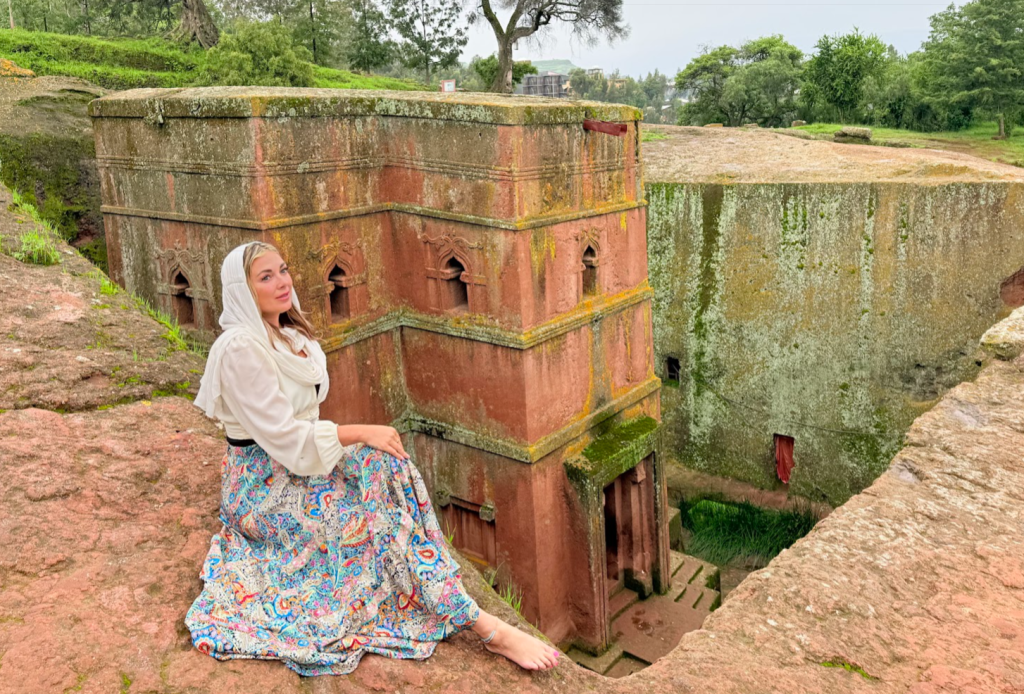
As someone who’s traveled solo to some pretty adventurous places, I felt quite safe in Lalibela, but like anywhere, a little preparation and common sense go a long way.
The Good News: Lalibela is a highly religious and sacred area, so there’s a general atmosphere of respect and spirituality. The local community is used to tourists and generally very friendly to visitors. Crime rates are low, and violent crime against tourists is rare.
Dress Respectfully: This is crucial. Cover your shoulders, wear long pants or skirts, and bring a scarf to cover your head when entering churches (not required but respectful). Not only is this respectful, but it also helps you blend in and avoid unwanted attention, or upsetting the locals! In fact, I had several comments on my TikTok video where I was wearing a hat instead of a full head scarf inside the church!
Stay Alert but Not Paranoid: Petty theft can happen anywhere, so keep your valuables secure and don’t flash expensive electronics unnecessarily. My guide kept asking me not to respond to the kids who wanted to talk to me because they would then ask for money or to buy something. But IMO, I’m glad I didn’t listen and still whispered to them, they were all genuinely just wanting to say hi – some would ask if I wanted to buy a trinket, but they weren’t badgering me about it.
Trust Your Guide: A reputable local guide isn’t just helpful for historical context – they’re also your cultural liaison and can help navigate any uncomfortable situations. Mine also doubled as a photographer.
Current Considerations: Check current political situations before traveling, as Ethiopia has experienced some regional tensions in recent years. Register with your embassy and keep emergency contacts handy.
Health Precautions: The altitude can affect some people, so take it easy your first day. Also, stick to bottled water and be cautious with street food if you have a sensitive stomach.
The locals I met were incredibly kind and curious about my solo journey. Many were amazed that I’d traveled so far alone just to see their churches, and their pride in sharing their heritage was genuinely touching.
Lalibela isn’t just a destination – it’s a journey into one of humanity’s most incredible architectural achievements, wrapped in living religious tradition and Ethiopian mountain culture. Yes, it takes effort to get there, and yes, it’s off the beaten path. But sometimes the most extraordinary experiences are hiding in the places most people have never heard of.
Have you ever had a destination stick in your mind for years before you finally made it there? What hidden wonders are currently on your “someday” list?
Please don’t forget! I work extremely hard to produce these free travel guides and posts! If it helped you, or you enjoyed it, PLEASE give it a share on social media, and follow me to keep up with more posts! You’re two minutes of effort truly helps keep my business running! Thank ya!
xx, Alyssa



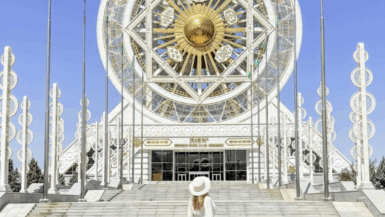
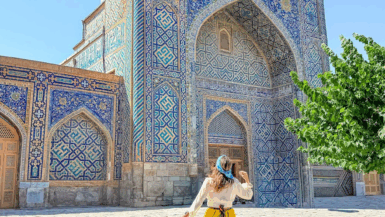
Such an amazing guide! Lalibela’s rock-hewn churches look truly incredible—I’d love to visit and see them in person someday.